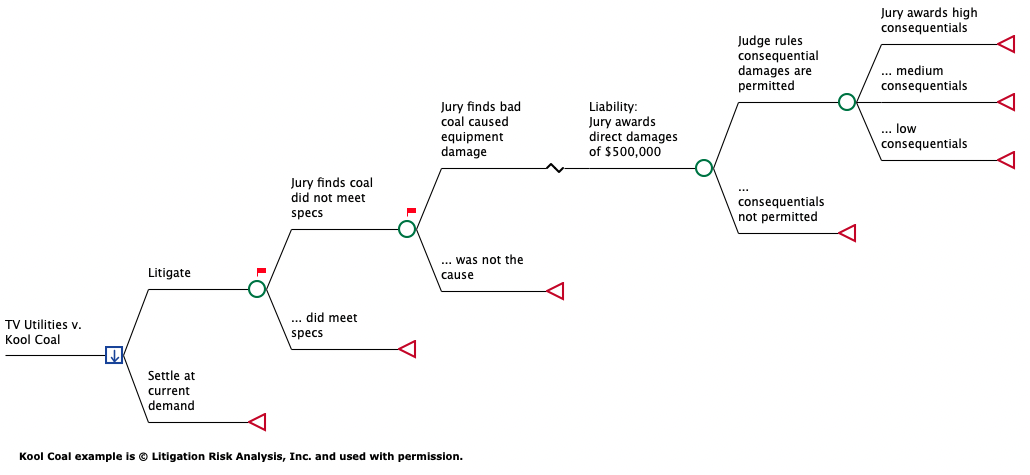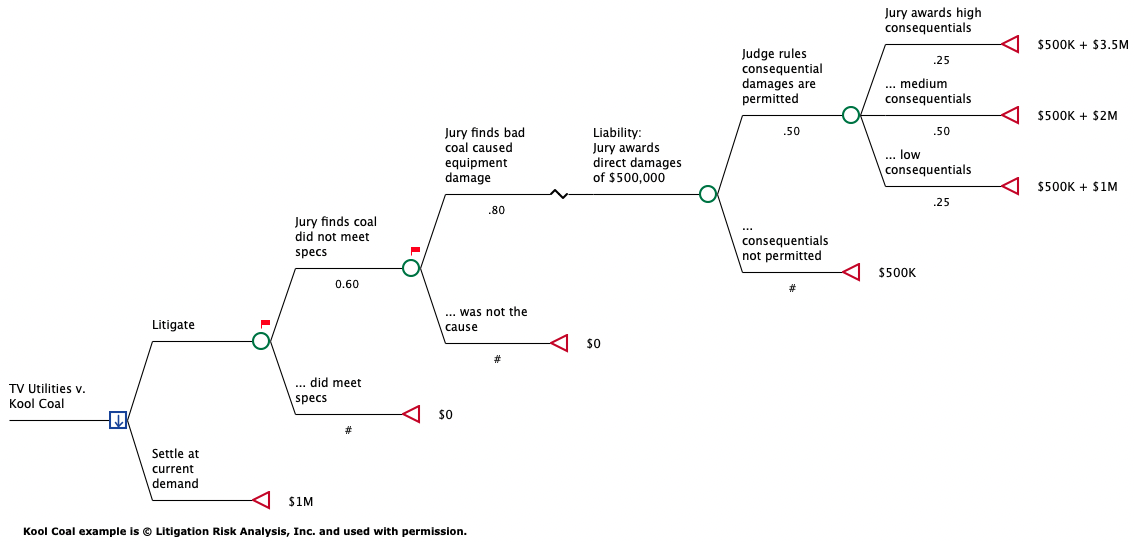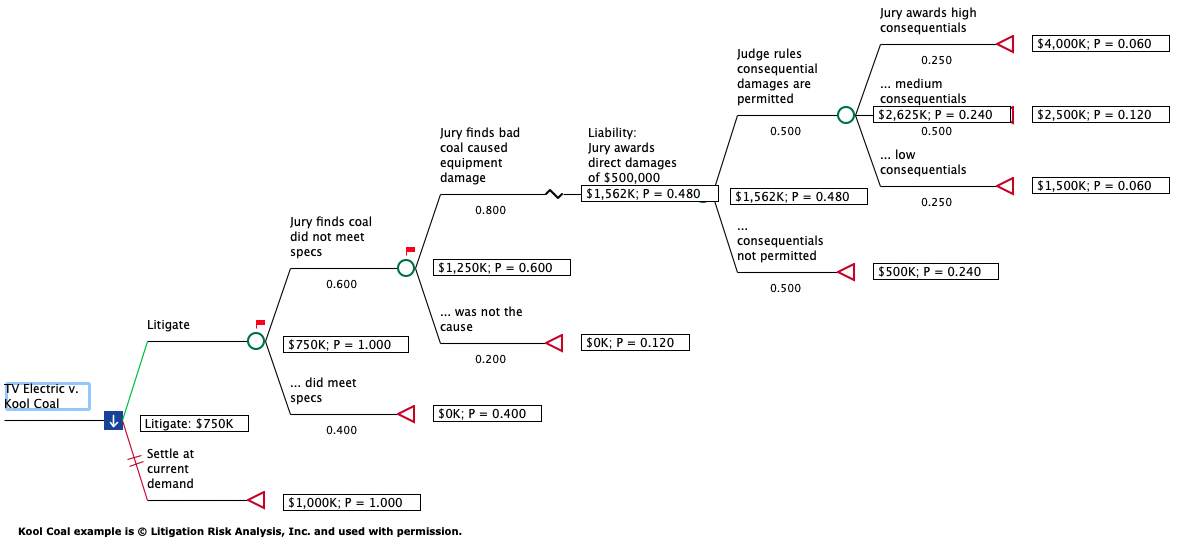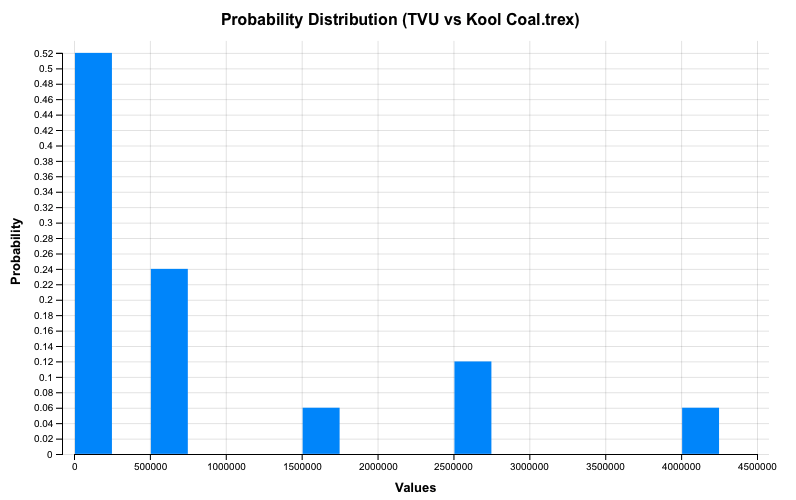2.1 Benefits of Modeling a Legal Case
When assessing a civil case, an attorney examines many pertinent factors, including the facts of the case, contracts, applicable laws, credibility of witnesses, etc. While lawyers have traditionally done this based on their own experience and expertise, a model can help organize those factors to perform a qualitative and quantitative analysis of the case. This can help formulate legal strategy and/or pursue settlement negotiations.
This section describes the basic purpose of a legal model and how to analyze it. Further details on building and analyzing models will be covered in chapter Build a Legal Model.
Let's consider an example breach of contract case - Legal Example model BreachOfContract.trex included as an Example model with TreeAge Pro.
Here are the important elements of the case.
-
We represent Kool Coal (KC) which is being sued by TV Utilities (TVU).
-
TVU claims the following:
-
KC provided coal that did not meet the contractual specifications.
-
As a result, TVU's equipment was damaged. TVU is demanding $500K in direct damages to repair equipment.
-
In addition, TVU claims that the damaged equipment caused a plant shutdown. TVU is demanding $3.5M in consequential damages for revenue lost during the shutdown.
-
-
TVU has demanded $1M to settle the case.
A lawyer must weigh the merits of the case - including uncertainty related to findings and financial consequences. TreeAge Pro can greatly aid in that analysis, providing the lawyer and client with a better understanding of the case's value and risk.
Let's examine how a model represents this case. We will examine how to build the model in chapter Build a Legal Model.

The model begins with a decision node (square) with branches to its right representing two legal strategies - Litigate or Settle. The Settlement strategy is an endpoint where we would accept TVU's settlement demand. However, the Litigate strategy branches into many pathways based on how the case could be decided in court.
For this example model, the finding of liability has been broken into two distinct issues:
-
Did KC provide coal that met specifications?
-
If not, did the coal cause the damage to the equipment?
If the jury finds the coal did not meet specifications and the coal caused the equipment damage, then KC will be found liable.
Note that liability is not an end point in this model. We need additional model scenario branches based on whether the judge will rule that consequential damages are permitted under the contract terms. Then there are further branches representing a range of consequential damages that could be awarded.
At this point, all pathways are terminated, and the model structure is complete. To complete the model, we need to add probabilities for different findings/rulings that split the model into different scenario pathways. We also need to add award estimates for each pathway endpoint. The image below shows the model with these values added.

We can now analyze the finished model. While TreeAge Pro supports several types of analysis, two are used most frequently.
-
Roll Back / Expected Value of Case
-
Probability Distribution / Risk Assessment
Roll Back calculates the Expected Value of the case by considering the value and likelihood of each pathway. Each pathway's value/outcome is weighted based on its likelihood - generating a weighted average of all possible outcomes. The image below shows the model when it is "rolled back".

Note that the award value and likelihood are calculated for each terminal node endpoint. Then values are rolled up from right to left based on probabilities.
TreeAge Pro calculates the value of each strategy by weighing the value of each outcome based on how likely that outcome is to occur.The top and least favorable outcome would result in a $4M award (outcome value), but that scenario is only 6% likely (probability/weighting of outcome). We have mapped out several possible outcomes for the Litigate strategy, and we need to consider all possible outcomes when calculating the overall Expected Value of the case.
Consider a simple example of a coin flip where you win $100 for heads and nothing if you lose. The value of that coin flip would be $50 - the weighted average of a 50% chance of winning the $100 and a 50% chance of winning nothing.
0.5 * $100 + 0.5 * $0 = $50
Decision trees, regardless of their complexity, work in a similar way. Rolling back the model calculates the value of each strategy via weighted average - resulting in an overall Expected Value of $750K for the Litigate strategy. The Settlement strategy has a single scenario of $1M (the demand from TVU). Given that it is the only scenario, it is weighed at 100% resulting in its Expected Value (EV) of $1M.
Representing the defendant, we would typically choose the strategy with the lower EV - Litigate at $750K over Settlement at $1M. While KC is not guaranteed to be better off going to court, it is more likely that KC will pay less in awards than it would by accepting the settlement offer.
Conclusions drawn from the model could prompt further settlement negotiations - perhaps agreeing to a figure closer to the Litigate strategy EV. However, let's assume that TVU will not agree to less than their original demand.
While it appears that KC should choose to go to court, there is risk of an outcome that far exceeds the settlement amount. The Probability Distribution graph provides a graphical representation of this risk for consideration by KC.

The graph above shows a range of potential awards along the x-axis, and the likelihood of those award values on the y-axis. This allows the client to assess risk of negative outcomes. The client might choose to settle for $1M to avoid possibly catastrophic awards of $2.5M or $5M. However, if KC can reasonably afford those worst-case scenarios, they would likely proceed with litigation based on the Litigate Expected Value being less than the $1M settlement demand.
Note that the probability distribution also shows the plaintiff's risk of litigation, indicating that it is more likely than not that KC will not be found liable at all. This could be helpful in negotiations.
Subsequent sections will demonstrate how to Build a Legal Model and provide additional details on how to Analyze a Legal Model.
